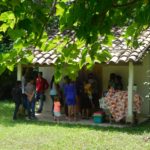Today’s missionary hero is Peter Claver, a missionary of the 17thCentury.
Peter Claver was born on June 26, 1581 in the Spanish village of Verdú to a prosperous farm farming family.
As a young man, he studied at the Jesuit-run University of Barcelona. In 1601, he entered the Society of Jesus (Jesuits) and made first vows on August 7, 1602. In his further studies in Majorca, Peter came in contact with a man who would greatly influence the rest of his life – the college porter, St. Alphonsus Rodríguez. It was Alphonsus who inspired Peter to become a missionary in the New World.
In April of 1610, after finishing his theological studies in Barcelona, the Jesuits chose Peter to represent the Jesuit province of Aragon in a group of Jesuits that was going to what was then called “New Granada,” today known as Colombia and Panama.
In April of 1610, Peter left Spain for the New World, never to return. He landed in Cartagena (Colombia). From there, he went to Bogotá to finish his theological studies. In that house, he worked as a sacristan, porter, nurse, and cook. After doing his tertianship year in Tunja, Peter returned to Cartagena in 1615 and was ordained a priest there on March 19, 1616.
As a newly ordained priest, Fr. Peter began his life’s work: to serve enslaved Africans who were being brought to Cartagena, a major slave center at that time. Peter was horrified at the inhumane way the Africans were treated, and he was so determined to devote his entire life to making their life better, that he took a fourth vow: to be the “slave of the Africans.”
Fortunately for Fr. Peter, he first served under the guidance of Jesuit Fr. Alfonso de Sandoval. Fr. Alfonso had worked with the enslaved Africans for over 40 years, and he had produced not only practical tips on how to help the slaves, but he also contributed much scholarly sociological and cultural anthropological ethnographic research for his writings.
For the next 40 years, Fr. Peter gave himself tirelessly to the care of the Africans. From his window in his rectory, he could see when new ships would arrive. Whenever he spotted a new ship arrive in the port, he would dash out of his house to meet the ship. There, he would do everything he could to reduce the fears of the terrified Africans and nurse them.
Fr. Peter, though his main focus was to care for the enslaved Africans, he also gave pastoral care to prisoners, crew members, slave owners, and others. Peter also worked as a nurse in the two hospitals of Cartagena. One of the hospitals was St. Sebastian, a general hospital run by the Brothers of St. John of God, and the other was St. Lazarus Hospital for lepers and those suffering from St. Anthony’s Fire (erysipelas).
Peter also devoted any hours to preaching in the streets of Cartagena. It is easy to see why many began calling Fr. Peter, “the Apostle of Cartagena.”
In his forty years, he instructed and baptized more than 300,000 people.
In 1650, when he was about 70, Peter went to preach to the enslaved African along the coast. Soon, however, he became sick and had to go back to Cartagena. He was the first of the Jesuits to catch the plague that was raging through the area, and it looked as though he might die. He recovered, however, but was never able to minister much again.
For the next four years, Fr. Peter was basically confined to his room. Unfortunately, the person who was assigned to care for him basically neglected him for four years. Fr. Peter never complained at his lack of care, however.
In 1654, a Fr. Diego Ramírez-Farina arrived from Spain to continue his work. Fr. Peter was so thrilled to hear the news that his loving work would continue among the Africans, that he dragged himself out of bed to greet his successor.
Fr. Peter died on September 7 or 8, 1654. Though the civil and religious authorities of his time often criticized his work among the enslaved Africans as “displaced enthusiasm,” then they competed with one another to give him honors. Peter was buried with a great ceremony, and Africans and Indians offered a second Mass in his honor.
Fr. Peter’s amazing life spread throughout the world. On January 15, 1888, Pope Leo XIII canonized Peter along with his mentor, Alphonsus Rodríguez.
St. Peter Claver’s feast day is September 9. He is a patron saint of all missionary activities among black-skinned peoples.



